Going Beyond the Requirements of US EPA Method TO-15: Cryogen-Free Monitoring of Trace-Level “Air Toxics” at High Humidity
The Column
This study describes the gas chromatography–mass spectrometry (GC–MS) analysis of trace-level “air toxics” in humidified cannister air, using cryogen-free preconcentration technology. We show that this method is able to detect 65 target compounds ranging from propene to naphthalene, with method detection limits as low as 0.7 pptv in SIM mode, making it compliant both with standard TO-15 methods, and with “trace TO-15” methods stipulating lower detection limits.
Photo Credit: SOUTHERNTraveler/Shutterstock.com

Mireia Aragon, Rui Li, and David Barden, Markes International, Gwaun Elai Medi-Science Campus, Llantrisant, UK
This study describes the gas chromatography–mass spectrometry (GC–MS) analysis of trace-level “air toxics” in humidified cannister air, using cryogen-free preconcentration technology. We show that this method is able to detect 65 target compounds ranging from propene to naphthalene, with method detection limits as low as 0.7 pptv in SIM mode, making it compliant both with standard TO-15 methods, and with “trace TO-15” methods stipulating lower detection limits.
With growing concerns over the harmful effects of long-term exposure to low levels of hazardous air pollutants (“air toxics”), there is increasing demand for analytical laboratories to detect ever lower levels of analyte concentrations in ambient air. Unfortunately, the detection limit criteria on the analytical instrumentation set by the widely used US EPA Method TO-15 (1) are not always able to address such needs. Therefore, some state environmental protection agencies in the US have developed new standard methods for lowâlevel air toxics.
One of these, released by the New Jersey Department of Environmental Protection, and known as “Low-level US EPA Method TO-15” (NJDEP LL TO-15) (2), sets lower reporting limits for the majority of the air toxics in US EPA Method TO-15, and in doing so moves the reporting limits for some compounds closer to health-based criteria.
Although traditional canister preconcentration technologies have long been used to quantitatively determine air toxics, significant challenges are posed by the ever greater range of analytes and concentrations of interest, and by the range of temperatures and humidities at sampling locations. Dealing with high levels of humidity is particularly important, because the ingress of water to the analytical instrument can negatively impact analyte response and repeatability, as well as reduce the lifetime of the column and detector.
This article demonstrates how a canister autosampler, trap-based water removal device, and thermal desorption–gas chromatography–mass spectrometry (TD–GC–MS) allow the analysis of a range of trace-level air toxics from air at 100% relative humidity (RH), in accordance with US EPA Method TOâ15 and related methods with lower detection limits.
Experimental
Standards: The 0.05 ppbv TO-15 standard was prepared by diluting 1 mL of a 1 ppbv standard (Restek catalogue no. 34436) with nitrogen, pressurized to 35 psig, and contained in 6-L canisters (SilcoCan, Restek). 100% RH was achieved by injecting 36-µL pure water into the canister at ambient laboratory temperature (21 °C).
Canister Sampling: Instrument: CIA Advantage-xr (Markes International); sample volume: up to 1000 mL.
Water Removal: Instrument: Kori-xr (Markes International); trap temperatures: –30 °C / +300 °C.
Thermal Desorption (TD): Instrument: UNITY-xr (Markes International); flow path: 160 °C; sample flow: 50 mL/min; postâsampling line purge: 5 min at 50 mL/min (with Kori-xr); trap purge: 1.0 min at 50 mL/min at 25 °C; focusing trap: “Trace TO-15” (part no. U-TO15-KXR); focusing trap low: –30 °C, then +25 °C for dryâpurge; focusing trap high: 300 °C (2 min); outlet split: 2 mL/min; trap heat rate: 40 °C/s.
GC: Column: 60 m × 0.32 mm, 1.80âμm J&W DB-624 (Agilent Technologies); constant flow: 2 mL/min; oven: 35 °C (5 min), 10 °C/min to 160 °C (0 min), 25 °C/min to 230 °C (5 min). The reduced amount of water in the preconcentrated sample allows the GC oven temperature to start at a relatively high temperature of 35 °C, for more efficient operation without compromising analyte peak shape.
Quadrupole MS: Source: 300 °C, transfer line: 200 °C; quadrupole: 200 °C; scan range: m/z 35–300.
Results and Discussion
System Operation: To achieve optimum results for 100% RH ambient air, the amount of residual water reaching the GC–MS system must be very low. This is ensured by first passing ambient air samples through an empty trap held below 0 °C that efficiently removes the majority of the water from the air stream while preserving the compounds of interest. Samples then pass into the thermal desorber, which contains a narrow, electrically-cooled focusing trap filled with separate beds of porous polymer, graphitized carbon black, and molecular sieve sorbents. The different strength of these sorbents ensures that compounds over a wide volatility range are quantitatively trapped. Both the waterâremoval and analyte-trapping parts of this system operate without liquid cryogen.
After sample collection at a trap temperature of –30 °C, the temperature is initially elevated to 25 °C, and the trap is purged with carrier gas in the sampling direction to eliminate oxygen and further reduce water from the focusing trap, while avoiding loss or breakthrough of the analytes retained. Finally, the flow of gas through the focusing trap is reversed, and the trap is heated rapidly to inject the analytes onto the GC column.
Chromatography: Figure 1 shows a typical total ion chromatogram for the ultralowâlevel 0.05 ppbv TO-15 standard at 100% RH. Note the excellent peak shape of the early eluting components (especially the light, polar compounds propene and isopropanol), indicating the effectiveness of the water removal approach and the excellent trap desorption efficiency.
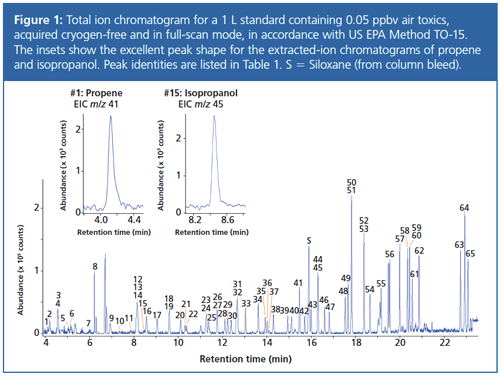
Linearities and Relative Response Factors: System linearity (R2) was assessed by sampling the 1 ppbv, 100% RH standard at 50 mL, 100 mL, 200 mL, 400 mL, 600 mL, 800 mL, and 1000 mL, equivalent to 1 L of a sample containing analytes at 0.05 ppbv, 0.1 ppbv, 0.2 ppbv, 0.4 ppbv, 0.6 ppbv, 0.8 ppbv, and 1 ppbv, respectively.
All linearities were >0.99 with an average of 0.9984 (Table 1). Figure 2 shows the excellent linearities for eight compounds spanning the range of volatilities and polarities, indicating that up to 1 L can be sampled without any breakthrough. From this data, the relative response factors (RRFs) and their relative standard deviations (RSDs) were calculated (Table 1), with a mean RSD of 6.0%, and no value being above 30% (as required by Method TO-15). This indicates that all the analytes are quantitatively retained and completely desorbed from the system.
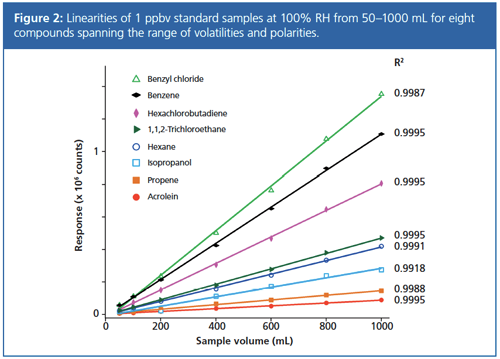
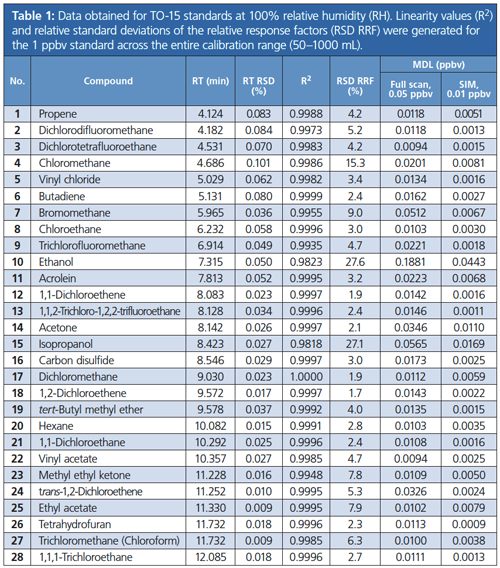
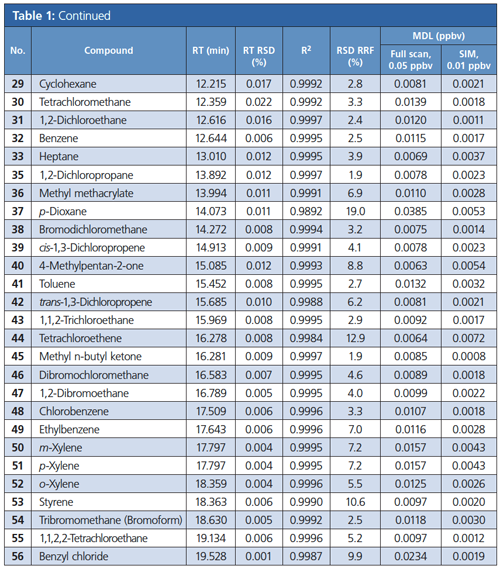
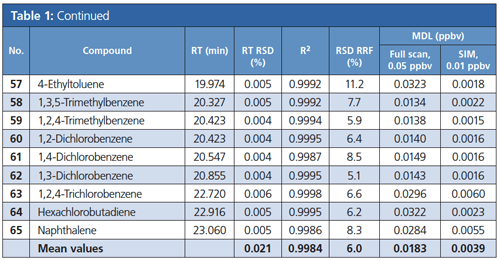
Background Level and Carryover: Systems suitable for analyzing trace-level samples must display reduced carryover from previous higherâconcentration samples, to avoid analytes in subsequent low-concentration samples being overâestimated (as well as eliminating the need for multiple blanks between samples).
To assess carryover, a system blank was run by sampling 1 L of nitrogen immediately after the highest concentration sample in the linearity runs (Figure 3). This result highlights the ability of the analytical system to recover quickly from being subjected to a high-concentration sample, with reduced carryover and a clean background for the next run.
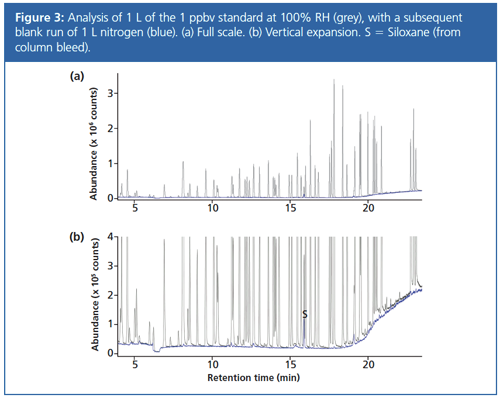
Method Detection Limits: To comply with Method TO-15, MDLs are required to be ≤0.5 ppbv. However, this reporting limit is too high for the analysis of traceâlevel air toxics encountered in a number of programmes, and the NJDEP LL TO-15 Method stipulates that MDLs should be ≤0.2 ppbv for the majority of the TO-15 compounds.
In this study, the MDLs were determined for seven replicates (with concentrations near the detection limit), using (a) 1 L of the 0.05 ppbv, 100% RH standard with full-scan mode, and (b) 1 L of the 0.01 ppbv, 100% RH standard with SIM mode. Values are listed in Table 1.
For the full-scan analysis, the mean MDL was 0.18 ppbv, with all but three values in the range 0.006–0.040 ppbv (the three outliers are ascribed to canister background contamination). Note that the NJDEP LL TO-15 Method requires a clean canister certification level of 0.20 ppbv-much higher than the 0.05 ppbv standards used for the MDL calculations in this work.
For the SIM analysis, the mean MDL was 0.0039 ppbv, with all values in the range 0.0007–0.0443 ppbv, and all but three compounds below 0.01 ppbv. These values are all significantly lower than the requirement of ≤0.2 ppbv stated by the NJDEP LL TO-15 Method.
Reproducibility: System reproducibility was investigated using the results of seven replicate runs of the 0.05 ppbv standard at 100% RH. The results are listed in Table 1 and show mean retention-time RSDs of 0.021%, with all but four compounds being 0.07% or below. This high degree of reproducibility makes it much easier to achieve precise automated quantitation, saving time when reviewing data. The consistency in retention time, peak shape, and abundance achieved indicates that the system is robust and stable, even for challenging lighter and polar compounds.
Conclusions
A system for trace-level canister analysis of “air toxics” in humid environments is described, comprising a canister autosampler, trap-based water-removal device, thermal desorber, and GC–MS system. This system allows confident analysis of a wide range of compounds in humid air in accordance both with US EPA Method TO-15 and (as a result of its significantly increased sensitivity) with more stringent protocols such as the NJDEP LL TO-15 Method.
A key feature of the results is the excellent chromatographic performance for the analysis of a 65-component TO-15 mix (including polar and nonpolar VOCs) at 100% RH, far exceeding all method requirements. Crucially, this performance has been achieved for even the most volatile of components in the TO-15 mix, because of the capacity of the analytical system to efficiently and selectively remove water from humid air, without compromising the analysis of very volatile organic compounds or polar species. In addition, the system uses electrical trap cooling throughout, eliminating the cost and inconvenience associated with liquid cryogen.
Acknowledgement
Kori-xr was developed in collaboration with the National Centre for Atmospheric Science (NCAS) at the University of York. It was co-funded by the UK’s innovation agency (Innovate UK), the Natural Environment Research Council (NERC), and the Welsh Government under the Knowledge Transfer Partnership programme.
References
- Compendium Method TO-15: Determination of volatile organic compounds (VOCs) in air collected in specially-prepared canisters and analyzed by gas chromatography/ mass spectrometry (GC/MS), Compendium of Methods for the Determination of Toxic Organic Compounds in Ambient Air (second edition), US EPA, 1999, www.epa.gov/homeland-security-research/epa-air-method-toxic-organics-15-15-determination-volatile-organic.
- NJDEP-SRP Low Level US EPA Method TO-15, Division of Remediation Management Response, New Jersey Department of Environmental Protection, www.nj.gov/dep/srp/guidance/vaporintrusion/newmethod2007/llto15.pdf.
Mireia Aragon received her Ph.D. from Universitat Rovira I Virgili, Tarragona, Spain, working on the GC–MS analysis of environmental samples. She was then involved in a two-year KTP project between the University of York and Markes International on the development of a TD accessory to remove water from air samples. Following this, Mireia started as a TD Product Specialist at Markes, where as part of the Product Development team she is involved in developing methodologies for TO-15 and PAMS analysis.
Rui Li received her Ph.D. in atmospheric sciences from the University of Colorado at Boulder, USA, in 2015. Following this, she joined Markes International as Environmental Marketing Manager, with responsibility for providing application support and advice on analytical techniques and instrumentation. An additional important role is marketing and business development in China, working closely with writers of standard methods, committees, manufacturers, test laboratories, and research institutes.
David Barden is technical copywriter at Markes, having joined the company in 2011. David studied natural sciences at the University of Cambridge, UK, and remained there for his Ph.D. in synthetic organic chemistry, which he received in 2003. A placement at Wiley-VCH, Germany, was then followed by seven years as a journals editor at Royal Society of Chemistry Publishing, UK.
E-mail: enquiries@markes.comWebsite: www.markes.com
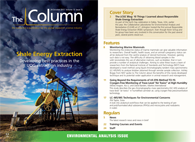
Characterizing Plant Polysaccharides Using Size-Exclusion Chromatography
April 4th 2025With green chemistry becoming more standardized, Leena Pitkänen of Aalto University analyzed how useful size-exclusion chromatography (SEC) and asymmetric flow field-flow fractionation (AF4) could be in characterizing plant polysaccharides.












